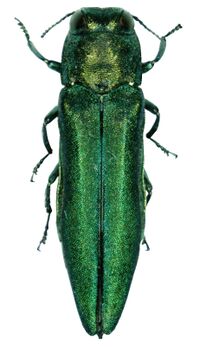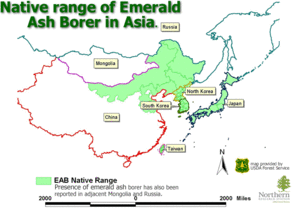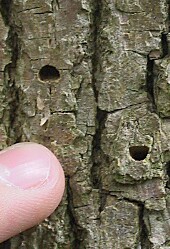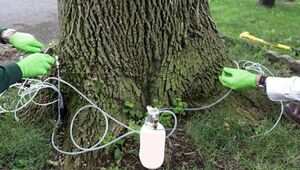Emerald Ash Borer
Also known as Agrilus planipennis, or simply EAB, the Emerald Ash Borer is a highly invasive species that is devastating Ash tree populations across North America. The adults are dark green with a metallic appearance and a bright red upper abdomen when the wings are extended; the larvae are white, segmented, flat-headed borers that will go through four larval instars before emerging as adults.
 | |
| Kingdom: | Animalia |
|---|---|
| Phylum: | Arthropoda |
| Class: | Insecta |
| Order: | Coleoptera |
| Family: | Buprestidae |
| Genus: | Agrilus |
| Species: | planipennis |
Background
EAB are native to Asia and were first documented in the United States in southeast Michigan in June 2002. It is believed that they arrived in wooden shipping pallets and other untreated wood products. In its native habitat EAB have several natural predators including multiple species of parasitoid wasps, however in North America there are currently no animals that eat it. There are studies being conducted examining the potential role that woodpeckers may have on the species [4].

Life Cycle
EAB go through three major life stages: the larvae, the pupae, and the adult. White eggs are laid with cracks and gaps in the ash tree bark and will turn a red-brown later on. Larvae eat through the bark and begin to develop within the cambium and inner phloem layers of the tree. They will feed on the tree creating long narrow channels within the sapwood, this is the stage when EAB do the most harm to the trees. After the larvae have fully matured they create a hollow in the outer bark where they fold into a J shape and develop into pupae and eventually adults. Once EAB have fully matured they eat through the bark leaving a characteristic D shaped hole behind them [7].

Adults will only emerge after there have been between 400 and 500 consecutive days above 50°F (10°C), and after they have emerged they will eat the leaves from the ash trees for a week prior to mating. On average adults can live for around six weeks and females will lay between 40 and 70 eggs, however some females that live longer can produce up to 200 eggs in their lifetime. This process can take one to two years, and the developing larvae can overwinter inside the trees however this will result in that individual taking an extra year to fully mature [7].
Effect of the EAB and Remediation Strategies
EAB are devastating ash tree populations across North America and currently there are no remediation strategies that have shown any promise of fully eradicating EAB. These insects do the most damage to their host trees as larvae, at this stage of their lives EAB will consume much of the cambium, inner phloem, and outer xylem layers while it matures and as a result the trees cannot effectively move water and nutrients through themselves. The adults also damage the ash trees by eating the leaves in late spring, but they do not have the same effect that the larvae do. Signs of infested trees include: large plates of bark falling off, long narrow galleries left behind under the bark from the larvae feeding, small D-shaped exit holes, and a thinning crown [1].


There are a combination of strategies that are currently being used to try and keep EAB population in check, however most of them are focused on treating the trees after they are infested and showing signs of decline in an attempt to prolong their lives. The four main treatments being used in an attempt to remove the EAB are: trunk injections, bark sprays, soil drenches, and ash tree removal and replacement [6]. Once a tree is infested there is a 50/50 chance that the treatments will be successful, however even if these chemical treatments are successful the trees will still have to be treated every 1-2 years to prevent EAB from returning. These treatments are extremely expensive and due to their relatively low success rate many private land owners typically select to have the trees removed and replaced before they die [1].

There are studies being done that are looking at the potential that native woodpeckers and parasitoid wasps may have in combating EAB. Within its native range the main predators of EAB are different species of parasitoid wasps, so many places including Purdue University, Colorado State, Michigan State, and Ohio State are studying whether or not native North American wasps would have any effect on EAB compared to their native predator wasps [5]. Additionally, one of the only animals in North America that will consistently eat EAB larvae are woodpeckers and an increased amount of woodpeckers can often be used as a sign that an ash tree has become infested with EAB. There are additional studies that are examining how woodpeckers may be used in the remediation of EAB—specifically the downy, hairy, and red-bellied woodpeckers are known the feed on EAB regularly [2].

Currently both of these strategies are not currently being employed on a large scale but there are studies that show that specifically using wasps to help curb EAB populations may be a useful and effective method. Currently there are four species of parasitoid wasps being used as biocontrols in an attempt to decrease EAB populations: Oobius agrili, Tetrastichus planipennisi, Spathius agrili, and Spathius galinae [4]. All four of these are non-native wasps from Asia that are specifically targetting EAB, and the USDA remains optimistic that the combined effects of woodpeckers, native and introduced parasitoid wasps, intraspecific competition, disease, tree defensive mechanisms, and overall reduced ash populations may help contribute to the collapse of EAB populations in the United States[3].
References
[1] Denver Parks and Recreation. 2016. Emerald Ash Borer Treatment Options. https://beasmartash.org/what-can-i-do/emerald-ash-borer-treatment/.
[2] Dickinson, J., and W. Hochakcha. 2013, August 8. Increase in Woodpecker Populations Linked to Feasting on Emerald Ash Borer.
https://www.nrs.fs.fed.us/news/release/woodpeckers-and-eab.
[3] Duan, J. J., L. S. Bauer, and R. G. Van Driesche. 2017. Emerald ash borer biocontrol in ash saplings: The potential for early stage recovery of North American ash trees. Forest Ecology and Management 394:64–72.
[4] Duan, J. J., R. G. V. Driesche, L. S. Bauer, R. Reardon, J. Gould, and J. S. Elkinton. 2019, June. The Role of Biocontrol of Emerald Ash Borer in Protecting Ash Regeneration After Invasion. USDA Forest Service.
[5] Farmer, S. 2015, September 22. Emerald Ash Borer and its Enemy Wasps. https://www.srs.fs.usda.gov/compass/2015/09/22/emerald-ash-borer-and-its-enemy-wasps/.
[6] Liesch, P., and R. C. Williamson. 2022, April 8. Homeowner Guide to Emerald Ash Borer Insecticide Treatments. https://hort.extension.wisc.edu/articles/homeowner-guide-emerald-ash-borer-insecticide-treatments/.
[7] USDA Forest Service. 2010, October 18. Invasive Species - Forest Disturbance Processes - Northern Research Station - USDA Forest Service. https://www.nrs.fs.fed.us/disturbance/invasive_species/eab/pubs/maps/.